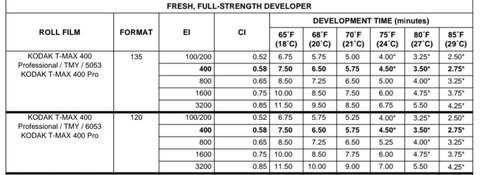Upon reviewing the Xtol table again, the transcription error appears to be more to do with the CI than the processing time. Kodak doesn't recommend increasing development time with 400TMY when rating it at 800. The processing times for each of the development methods and temperatures has the same development time when rating it at 800 as when rating it at 400. This conforms with their recommendation. They just forgot to change for CI value for the 800 EI to 0.56. They would then probably need to change the CI values for EI 1600 and 3200. If they are using 0.56 for both 400 and 800, the other CI values need to be shifted down.
I also noticed a note on the 400TMY data sheet. It said that the T-Max films have less sensitivity to blue light than most other black and white films.

What follows is speculation. The 100TMX doesn't appear to have the same note, and it also doesn't have the same processing suggestion for EI 100 and EI 200 ratings. My first thought had to do with the development velocity of 400TMY. The time/CI charts in the data sheet didn't help. The way they are designed creates steep, straight curves which I found hard to interpret. While it may have something to do with this, it may also have something to do with the blue sensitivity. In general, black and white film tends to have a little extra blue sensitivity. When determining the ISO speed, the sensitometer color temperature is at daylight. It was changed in the 1960s from sunlight. This change required the speed constant in the speed equation to be adjusted by 1/3 stop to adjust for the increase in blue light which would have made the film appear faster than it actually is. So the 0.80 in the speed equation 0.80 / H
m compensates for the speed increase from the bluer light.
If the film doesn't have a higher blue sensitivity, the higher Kelvin wouldn't necessary affect the speed, so the 1/3 stop adjustment would rate the speed 1/3 stop slower than it actually is. Depending on the blue sensitivity, the film's response could be even less sensitive to blue, so by testing the film using the ISO Standard, an ISO 400 for 400TMY could be equivalent to an ISO 500 or 640 of other films when used in shooting conditions. If this is the case, adjusting the processing for an EI 800 wouldn't be necessary.







